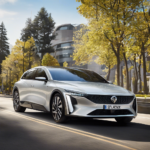# 5G Technology’s Impact on Connected Cars: Transforming the Automotive Landscape
The automotive industry is undergoing a significant transformation, and at the heart of this revolution is 5G technology. This next-generation wireless network is not just about faster download speeds; it’s about unlocking unprecedented capabilities for connected cars and reshaping our driving experiences. As 5G networks roll out globally, the impact on the automotive sector is becoming increasingly evident, and the roads of today are witnessing a rapid evolution.
## Enhanced Connectivity and Real-Time Communication
5G technology offers blazing-fast connectivity, with speeds up to 100 times quicker than 4G networks. This leap in speed enables connected cars to communicate with each other and the surrounding infrastructure in real-time. Imagine vehicles that can ‘talk’ to each other, sharing vital information about traffic conditions, accidents, or road hazards. This level of connectivity can significantly enhance road safety and traffic management, reducing the number of accidents and improving overall efficiency.
For instance, vehicles equipped with 5G technology can receive immediate alerts about a sudden traffic jam ahead, allowing drivers to take alternative routes promptly. This real-time communication can also enable advanced driver-assistance systems (ADAS) to make more informed decisions, such as adjusting speed or suggesting lane changes to maintain a safe distance from nearby vehicles.
## Low Latency for Autonomous Driving
One of the most exciting prospects of 5G for connected cars is its potential to accelerate the development of autonomous vehicles. The ultra-low latency of 5G networks, with delays measured in milliseconds, is crucial for self-driving cars, which need to make split-second decisions based on sensor data and environmental inputs.
With 5G, autonomous vehicles can analyze and respond to their surroundings with remarkable speed and accuracy. This includes detecting and identifying objects, processing complex data, and executing driving decisions with minimal delay. As a result, self-driving cars can navigate more safely and efficiently, bringing us closer to a future where autonomous transportation is commonplace.
## Improved Infotainment and In-Car Experiences
The impact of 5G on in-car infotainment systems will be transformative. High-speed, low-latency 5G networks will enable seamless streaming of high-definition media, allowing passengers to enjoy immersive entertainment experiences during their journeys. From streaming movies and gaming to accessing cloud-based applications and services, the possibilities are endless.
Furthermore, 5G can support advanced augmented reality (AR) and virtual reality (VR) applications, enhancing the overall driving experience. Imagine interactive heads-up displays that provide real-time information about the surrounding environment, or immersive VR experiences for backseat passengers, turning long journeys into engaging adventures.
## Vehicle-to-Everything (V2X) Communication
5G technology enables Vehicle-to-Everything (V2X) communication, a concept that allows vehicles to exchange data with everything around them, including other vehicles, infrastructure, and pedestrians. This opens up a world of possibilities for enhancing road safety, traffic management, and overall transportation efficiency.
For example, V2X communication can enable vehicles to receive alerts about pedestrians crossing the road ahead, even if they are obscured from the driver’s view. Similarly, it can facilitate communication between vehicles and traffic lights, optimizing traffic flow and reducing congestion. The potential benefits of V2X communication are vast, promising a safer and more efficient future for transportation.
## Telematics and Fleet Management
The rapid adoption of 5G technology also brings significant advantages to fleet management and telematics. High-speed data transmission enables real-time tracking and monitoring of vehicles, providing valuable insights for fleet operators. This includes tracking vehicle performance, fuel efficiency, and driver behavior, allowing companies to optimize their operations and reduce costs.
Moreover, 5G-enabled telematics can facilitate over-the-air (OTA) updates, ensuring that vehicles remain updated with the latest software and security patches without requiring physical access. This capability is particularly valuable for fleet managers, as it simplifies maintenance and ensures vehicles operate at peak performance.
## Conclusion
The impact of 5G technology on connected cars is undeniable, and it is reshaping the automotive industry as we know it. From enhanced safety and real-time communication to improved infotainment and autonomous driving capabilities, 5G is the catalyst for a new era of mobility. As 5G networks continue to expand and mature, we can expect even more innovative applications and use cases to emerge, further transforming our driving experiences and making roads safer and more efficient. The future of connected cars is here, and it is powered by 5G technology.










